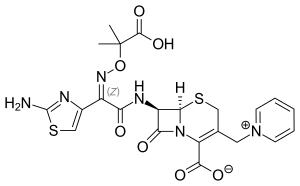Fortaz
 |
|
 |
|
| Clinical data | |
|---|---|
| Pronunciation | /sɛfˈtæzᵻdiːm/ |
| Trade names | Fortaz, Tazicef, others |
| AHFS/Drugs.com | Monograph |
| MedlinePlus | a686007 |
| Pregnancy category |
|
| Routes of administration |
intravenous, intramuscular, inhalation (off-label only) |
| ATC code | |
| Legal status | |
| Legal status |
|
| Pharmacokinetic data | |
| Bioavailability | 91% (IM) |
| Metabolism | negligible |
| Biological half-life | 1.6–2 hours |
| Excretion | 90–96% kidney |
| Identifiers | |
|
|
| CAS Number | |
| PubChem CID | |
| DrugBank | |
| ChemSpider | |
| UNII | |
| ChEBI | |
| ChEMBL | |
| ECHA InfoCard | 100.112.489 |
| Chemical and physical data | |
| Formula | C22H22N6O7S2 |
| Molar mass | 546.58 g/mol |
| 3D model (Jmol) | |
|
|
|
|
|
|
|
Ceftazidime, sold under the brand names Fortaz among others, is an antibiotic useful for the treatment of a number of bacterial infections. Specifically it is used for joint infections, meningitis, pneumonia, sepsis, urinary tract infections, malignant otitis externa, pseudomonas aeruginosa infection, and vibrio infection. It is given by injection into a vein or muscle.
Common side effects include nausea, allergic reactions, and pain at the site of injection. Other side effects may include Clostridium difficile diarrhea. It is not recommended in people who have had previous anaphylaxis to a penicillin. Its use is relatively safe during pregnancy and breastfeeding. It is in the third-generation cephalosporin family of medications and works by interfering with the bacteria's cell wall.
Ceftazidime was patented in 1978 and came into commercial use in 1984. It is on the World Health Organization's List of Essential Medicines, the most effective and safe medicines needed in a health system. Ceftazidime is available as a generic medication. The wholesale cost in the developing world is about 2.84 to 16.76 USD per day. In the United States a course of treatment costs 100 to 200 USD.
...
Wikipedia
